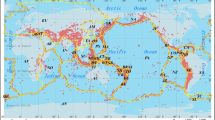Abstract
Before the 1944 Tonankai earthquake along the Nankai Trough, seismic activity increased in the shallow depths, and then the activity gradually migrated downwards. When it reached its limit (a depth of approximatelty 70 km), the main shock occurred. Several deep earthquakes, including one ofM5.3, occurred several months prior to the Tonankai earthquake. A similar downward migration pattern also can be recognized regarding the 1952 Tokachi-oki earthquake. In this case the deepest earthquakes reached about 400 km. This may be one of the intermediate-term precursory phenomena of great thrusttype earthquakes in subduction zones. Recent observations in the Tokai district along the Suruga Trough, where a large earthquake is expected to occur in the future, suggest a similar downward migration pattern in the land area.
Similar content being viewed by others
References
Association for the Development of Earthquakes Prediction (1983),Precursory phenomena of earthquakes, (2) The Tonankai earthquake. Ass. Develop. Earthquake Predict., Tokyo (in Japanese).
Inouye, W. (1965),On the seismicity in the epicentral region and its neighborhood before the Niigata earthquake. Quarterly Journal of Seismology29, 31–36 (in Japanese).
Katsumata, M. andYoshida, A. (1980),Change in seismicity and development of the focal region. Papers in Meteorology and Geophysics31, 15–32.
Mizoue, M., Nakamura, M., Seto, N., Ishiketa, Y. andYokota, T. (1983),Three-layered distribution of microearthquakes in relation to focal mechanism variation in the Kii Peninsula, southwestern Honshu, Japan. Bull. Earthquake Res. Inst., Univ. Tokyo58, 287–310.
Mogi, K. (1969),Some features of recent seismic activity in and near Japan (2), Activity before and after great earthquakes. Bull. Earthquake Res. Inst., Univ. Tokyo47, 395–417.
Mogi, K. (1973),Relationship between shallow and deep seismicity in the western Pacific region. Tectonophysics17, 1–22.
Mogi, K. (1981),Seismicity in western Japan and long-term earthquake forecasting. InEarthquake Prediction, An International Review (ed. D. W. Simpson and P. G. Richards) (Maurice Ewing Ser.4, 43–51, AGU, Washington, D.C., 1981).
Mogi, K. (1984/85),Temporal variation of crustal deformation during the days preceding a thrust-type great earthquake—the 1944 Tonankai earthquake of magnitude 8.1, Japan. PAGEOPH122, 765–780.
Mogi, K. (1985),Earthquake Prediction (Academic Press, New York).
Mogi, K. (1986),Recent earthquake prediction research in Japan. Science233, 324–330.
Mogi, K. (1987a),Recent seismic activity in the Tokai (Japan) region where a large earthquake is expected in the near future. Tectonophysics138, 255–268.
Mogi, K. (1987b),Presursory seismic activity before the 1944 Tonankai (Japan) earthquake—Focusing on the downward migration of seismic activity. Tectonophysics139, 205–221.
Mogi, K. (1987c),The relation between the duration of long-term precursors and the magnitude of the subsequent earthquake. Tectonophysics142, 163–172.
Ohtake, M. (1980),Earthquake prediction based on the seismic gap with special reference to the 1978 Oaxaca, Mexico earthquake. Report of the National Research Center for Disaster Prevention23, 65–110 (in Japanese).
Raleigh, C. B., Benett, G., Craig, H., Hanks, T., Molnar, P., Nur, A., Savage, J., Scholz, C., Turner, R., andWu, F. (1977),Prediction of the Haicheng earthquake. EOS Trans. Amer. Geophys. Un.58, 236–272.
Rikitake, T. (1975),Earthquake precursors, Bull. Seismol. Soc. Am.65, 1133–1162.
Rikitake, T. (1979),Classification of earthquake precursors. Tectonophysics54, 293–309.
Sato, H. (1977),Some precursors prior to recent great earthquakes along the Nankai trough. J. Phys. Earth25, Suppl., S115-S121.
Scholz, C. H., Sykes, L. R. andAggarwal, Y. P. (1973),Earthquake prediction: A physical basis. Science181, 803–809.
Tsubokawa, I. (1969),On relation between duration of crustal movement and magnitude of earthquake expected. J. Geod. Soc. Japan15, 75–88 (in Japanese).
Utsu, T. (1968),Seismic activity in Hokkaido and its vicinity. Geophys. Bull. Hokkaido Univ.20, 51–75 (in Japanese).
Whitcomb, J. H., Garmany, J. D. andAnderson, D. L. (1973),Earthquake prediction: variation of seismic velocities before the San Fernando Earthquake. Science180, 632–635.
Yamazaki, F. andOoida, T. (1985),Configuration of subducted Philippine Sea Plate beneath the Chubu District, central Japan. J. Seismol. Soc. Japan38, 193–201 (in Japanese).
Author information
Authors and Affiliations
Rights and permissions
About this article
Cite this article
Mogi, K. Downward migration of seismic activity prior to some great shallow earthquakes in Japanese subduction zones—a possible intermediateterm precursor. PAGEOPH 126, 447–463 (1988). https://doi.org/10.1007/BF00879006
Received:
Revised:
Accepted:
Issue Date:
DOI: https://doi.org/10.1007/BF00879006




